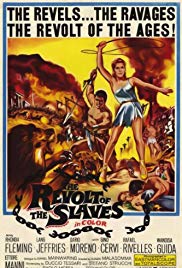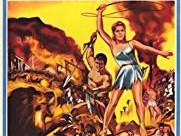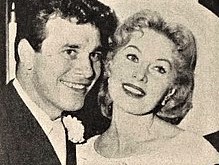The Revolt of the Slaves [La Rivolta degli Schiavi] ** (1960, Rhonda Fleming, Lang Jeffries, Darío Moreno, Ettore Manni, Gino Cervi, Fernando Rey, Serge Gainsbourg) – Classic Movie Review 7935

In 1954 Rhonda Fleming travelled to Italy to play Semiramis in The Queen of Babylon and she also travelled to Italy again – and also Spain – to make The Revolt of the Slaves in 1960.
Rhonda Fleming stars as ancient Roman patrician’s daughter Fabiola, who falls for a handsome young Christian slave called Vibio (Lang Jeffries). Nevertheless, the fiery Fabiola has Vibio flogged for disobeying an order.
Fleming and her then new fourth husband Jeffries shine alluringly in director Nunzio Malasomma’s lusty, expensive and good-looking but sluggishly paced and carelessly assembled 1960 European romantic adventure tale of the early Christians. It is entertaining, and certainly plenty kitsch and campy.
The Revolt of the Slaves [La Rivolta degli Schiavi] also stars Ettore Manni as San Sebastiano [Saint Sebastian], Gino Cervi as Claudio, Fernando Rey as Valerio and Serge Gainsbourg as Corvino. It is based on the novel Fabiola by Nicholas Patrick Wiseman. It is shot in Technicolor and Totalscope by Cecilio Paniagua.
Also in the cast are Wandisa Guida as Agnese, José Nieto as Fabiola’s servant Sesto, Rainer Penkert as Massimo, Antonio Casas as Tertulio and Dolores Francine as Liubaia.

The Revolt of the Slaves was released in Italy on 20 December 1960 at 100 minutes, in the US in June 1961 at 102 minutes and in West Germany as Die Sklaven Roms on 17 March 1961.
The Revolt of the Slaves [La Rivolta degli Schiavi] is directed by Nunzio Malasomma, runs 100 minutes, is made by Ambrosiana Cinematografica, C.B. Films S.A and Ultra Film, is released by United Artists, is written by Stefano Strucchi, Duccio Tessari and Daniel Mainwaring (English dialogue), is shot in Technicolor and Totalscope by Cecilio Paniagua, is produced by Paolo Moffa, is scored by Angelo Francesco Lavagnino and designed by Ramiro Gómez.
Rhonda Fleming (August 10, 1923 – October 14, 2020) married Lang Jeffries (1930–1987) on 3 April 1960 at The Little Church of the West in Las Vegas, but they soon divorced on 11 January 1962. Jeffries (born Hubor William Lappin) served in the US Army in the Korean War and was one of only three survivors of his unit’s 177 soldiers who landed at Inchon in autumn 1951.
Jeffries persuaded the film’s producers to cast him as Vibio after he went to Rome with Fleming and found they had no leading man. In Madrid to film, they discovered Italian director Malasomma would not speak to them, so Jeffries directed them both.
© Derek Winnert 2018 Classic Movie Review 7935
Check out more reviews on http://derekwinnert.com


